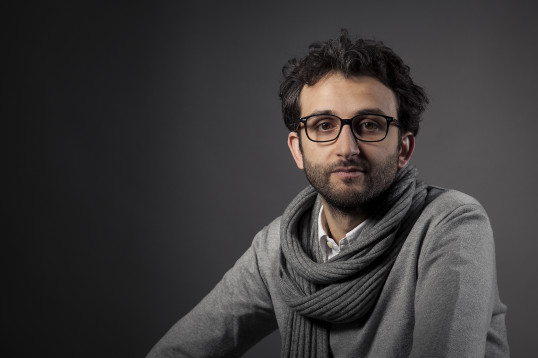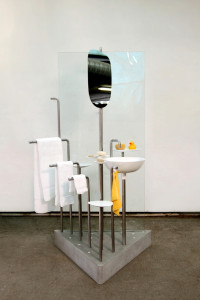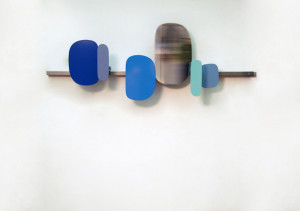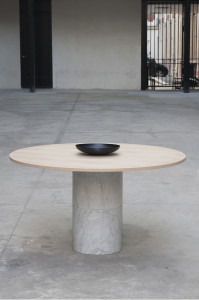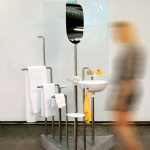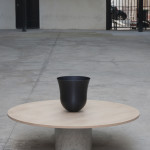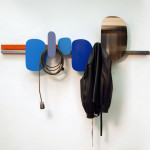1. Parlami un po di te… chi sei, dove vivi, quanti anni hai e gli studi che hai fatto…?
1. Tell me something about yourself… Who are you, where do you live, how old are you, what did you study (at university)?
Sono nato a New York, Albert Schrurs (1985 / Svizzera) e mi sono laureato in Architettura presso lo EPFL (Istituto Federale Svizzero di Tecnologia di Losanna). Successivamente ho conseguito una laurea in Luxury Designer all’ECAL MAS (Università di Design e Arti di Losanna). Prima di dedicarmi alla Allegory Studio nel Settembre 2011, ho lavorato come architetto per Louis Vuitton e per diverse aziende famose, tra cui Shigeru Ban (Pritzker Price 2014), Jacques Lucan, Kengo Kuma e Ma Yansong, a Parigi, Tokyo e Pechino. Albert Schrurs è il fondatore di Allegory Studio. Vive e lavora a Ginevra, in Svizzera.
Born in New York, Albert Schrurs (1985 / Swiss) is an EPFL graduate Architect (Swiss Federal Institute of Technology Lausanne) and an ECAL MAS Luxury graduate Designer (University of Arts and Design Lausanne). Before dedicating himself to Allegory Studio in September 2011, he worked as an Architect for Louis Vuitton and for several famous firms, among which Shigeru Ban (Pritzker Price 2014), Jacques Lucan, Kengo Kuma and Ma Yansong, in Paris, Tokyo and Beijing. Albert Schrurs is Allegory Studio’s founder. He lives and works in Geneva, Switzerland.
2. Cos’è per te il design?
2. What does design mean to you?
Essendo un architetto, il design è un’opportunità di lavorare su piccoli oggetti, interrogarsi sulla routine quotidiana, sul comportamento umano ed il rapporto verso lo spazio. La maggior parte dei miei progetti di design includono anche una riflessione scenografica.
Being an Architect, design is an opportunity to work on smaller objects, interrogate myself on daily routines, human behaviour, relationship towards space. Most of our design projects include also include a scenographical reflexion
3. Qual’è la tua filosofia per la progettazione degli oggetti?
3. Do you have a personal design philosophy? How would you describe it?
Sullivan ha dichiarato: “La forma segue la funzione”, e Mies van der Rohe ha detto “Less is more” … penso che avessero ragione su molte cose. Non so se posso pretendere di avere una filosofia, ma noi non ci concentriamo sulla interazione tra l’oggetto e il suo utente. Si può evolvere un oggetto o può essere ancora vivo anche se non è in uso?
Sullivan said “Form follows function”, and Mies van der Rohe said “Less is more”… I think they were right on many things.
I don’t know if I can pretend to having a philosophy, however we do focus on the interaction between the object and its user. How does one affect the other. Can the object evolve, can the object still be alive, even if it isn’t in use?
4. Quali sono i materiali che preferisci?
4. Which materialsdo you use the most in your projects?
Io mi diverto tantissimo lavorando con il metallo
I really enjoy working with metal
5. Raccontami brevemente gli oggetti che mi hai inviato…
5. Tell me something about the objects you have sent me…
ROUNDABATH è una proposta di design di concepire il «bagno» come un oggetto modulare e non come uno spazio. Osservando l’evoluzione delo spazio bagni fino ad ora, sembra che sia pronto (a parte il WC) per essere integrato in camera da letto. L’utente gira intorno ad un oggetto indipendente per godersi le diverse funzioni (doccia, lavabo + specchio, organizer + display), piuttosto che trovarsi al suo centro e con tutte le funzioni contro il muro. L’utente può anche personalizzare la visualizzazione degli elementi, ad eccezione di quelli che sono legati all’acqua.
ROUNDABATH is a design proposal to conceive the «bathroom» as a modular object and not as a space. Observing the evolution of bathrooms as spaces until now, it seems like it is ready (aside from the toilet) to be integrated in the bedroom. The user turns around a freestanding object to enjoy the different functions (shower, sink + mirror, organizer + display), rather then finding himself in the center and having all the functions against the wall. The user can also customize the display of the elements, except for those which are connected to water.
PEBBLE è progettato per un ingresso, l’oggetto è modulare e permette ad ogni individuo di appropriarsi dell’oggetto e riorganizzarlo per soddisfare meglio le sue esigenze. Il risultato è quasi sempre artistico e unico. L’oggetto combina diverse funzioni: vassoio tasca, appendiabiti, specchio. L’utente può aggiungere o rimuovere elementi come quanto vuole.
PEBBLE is designed for an entrance, the object is modular, and allows each individual to self appropriate the object and reorganize it to best meet his needs. The result is quite always artistic and unique. The object combines several functions: pocket tray, coat peg, mirror. The user can add or remove elements as much as he wants.
Totem è un sistema di tavoli modulare composto da tre tipologie di elementi. Pesanti sgabelli in pietra sovrapponibili permettono di definire varie altezze tavolo, sul quale vengono regolati da pannelli di legno di vari diametri, consentono di modificare la misura del tavolo. La piastra e lo sgabello sono tenute insieme da un accessorio posto nell’asse centrale in alluminio (lampada, vaso, ciotola) che definisce la funzione del tavolo. Questo sistema permette all’utente di avere è oggetto che si evolve e si adatta a nuovi ambienti e occasioni speciali.
Totems is a modular table system composed of three element typologies. Heavy stackable stone stools allow to define various table heights, on which wood plates of various diameters are then set, they allow to change the table’s size. The plate and the stool are hold together by a central axis aluminium accessory (lamp, vase, bowl) which defines the table’s function. This system allows the user to have is object evolve and adapt itself to new environments or special occasions.
6. Quali sono i tuoi progetti futuri?
6. Do you already have any project for the future?
Allegory Studio sta attualmente lavorando su una terrazza di un ristorante panoramico, un paio di lavori di ristrutturazione di appartamenti, un angolo per un marchio di orologi, una scenografia mostra, alcuni progetti di installazione di luce, così come sul proprio spazio.
Allegory Studio is currently working on a Rooftop restaurant’s terrace, a few apartment renovations, a corner for a watch brand, an exhibition scenography, some light installation projects, as well as on their own office space.
7. Quale oggetto del passato ti piacerebbe aver progettato?
7. There is an object of the past that you wish you had designed?
Crystallize Chair di Tokujin Yoshioka
Crystallize Chair by Tokujin Yoshioka
8. Alla premiazione degli Oscar Paolo Sorrentino ha citato il suo Pantheon di personaggi che hanno ispirato la sua vita, fra i quali Fellini e Maradona. Tu chi inseriresti nel tuo Pantheon ?
8.Paolo Sorrentino during his ‘Great Beauty’ Oscar Acceptance speech appointed Fellini, Madonna and Scorsese as their inspirers. Do you have any? Who are they?
Shigeru Ban, Renzo Piano, Olafur Eliasson, Tokujin Yoshioka
Shigeru Ban, Renzo Piano, Olafur Eliasson, Tokujin Yoshioka
9. Ritieni che l’autoproduzione dei propri pezzi sia la nuova via per i designer?
9. Do you think that self-production is a new possible way for designers to make their design?
Si e no
Yes and No
10. Qual’è il tuo rapporto con la cucina? (Hai mai progettato oggetti per la cucina?)
10. Which kind of relation do you have with the kitchen and the cooking? (Have you ever designed kitchen tools?)
Abbiamo già progettato Francia per Bernardaud, una collezione di piatti, e Rooftop ° 42, un ristorante a Ginevra.
We’ve previously designed France for Bernardaud, a collection of plates, and Rooftop°42, a restaurant in Geneva.
11. Dimmi qual’è la tua ricetta culinaria preferita. Inviamela o dammi un link dove posso trovarla.
Khoresht Ghaimeh ~ Persian Stew with Meat & Split Peas
Il primo piatto di cui vorrei parlare è di gran lunga uno dei miei preferiti: khoresht Ghaimeh. Si tratta di una deliziosa miscela di carne, piselli spezzati, pomodori e spezie, condita con patate fritte. Non solo questo piatto è davvero buono, è anche molto facile da fare. Quello che mi piace anche di questo piatto è la semplicità degli ingredienti e quanto bene vanno insieme. Ho fatto questa ricetta un paio di volte che è stato un successo con i nostri ospiti.
The first dish that I would like to talk about is by far one of my most favorites: Khoresht Ghaimeh. This is a delicious blend of meat, split peas, tomatoes, and spices topped with French Fries. Not only this dish is really good, it is also a very easy one to make. What I also love about this dish is the simplicity of the ingredients and how well they go together. I have made this recipe a few times a it has been a hit with our guests.
Senza ulteriori ecco la ricetta…
